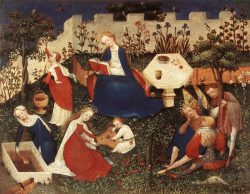 SHAFTESBURY once had one of England’s greatest abbeys and convents, destroyed in Henry VIII’s Dissolution of the Monasteries – all that remains is an atmospheric and peaceful walled garden off Park Walk. So the subject for this year’s Shaftesbury Abbey Museum & Gardens Spring Lecture on Wednesday 22nd May is highly appropriate.
SHAFTESBURY once had one of England’s greatest abbeys and convents, destroyed in Henry VIII’s Dissolution of the Monasteries – all that remains is an atmospheric and peaceful walled garden off Park Walk. So the subject for this year’s Shaftesbury Abbey Museum & Gardens Spring Lecture on Wednesday 22nd May is highly appropriate.
Caroline Holmes, a lecturer, author and consultant designer, will give her talk on the history, beauty and symbolism of “The Medieval Garden – Use and Delight, Romance and Religion”, in Shaftesbury Arts Centre at 7.30pm.
As a garden historian she researches ancient, modern and contemporary gardens. Academic but not dry, informative and entertaining, her lectures explore people, plants and places delving into the myriad ways they have historically shaped their landscapes.
As an academic tutor and course director for the University of Cambridge Institute of Continuing Education and a lecturer for The Arts Society, she has spoken or researched on every continent except Antarctica and has received awards for her writing and broadcasting www.horti-history.com
She says: “Apart from contemporary prose and poetry, medieval illuminated manuscripts and tapestries are important reference sources for medieval gardens and their plants. We explore their use and evolution in the period 410–1485AD – from monastic enclosure to royal hunting park and the desire for an earthly paradise both as a Christian and romantic metaphor.
“We chart the development of simple, monastic, self-sufficient food, medicinal and sacristan plots into elaborate ecclesiastical palace and abbey gardens not forgetting the heavily defended castles with their survival crops and manors with walled gardens relishing the wafting scents from plantings below status rooms.”
For tickets or more information visit www.shaftesburyartscentre.org.uk or call 01747 854321
Pictured is an anonymous medieval painting of Mary in the Paradise Garden with saints.